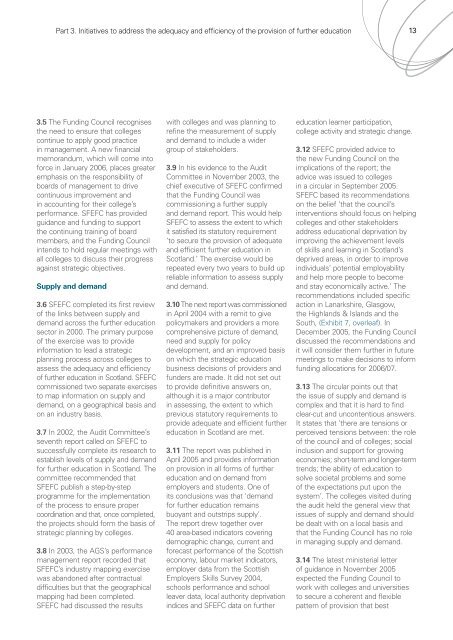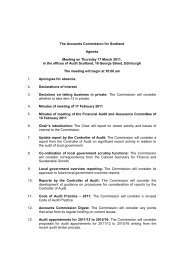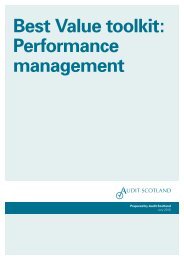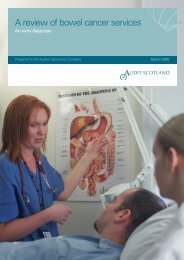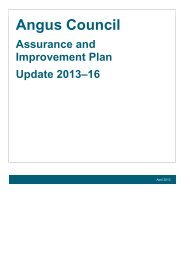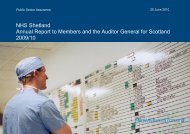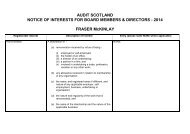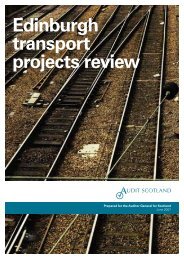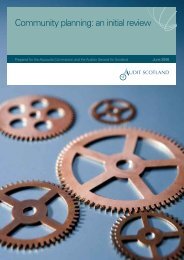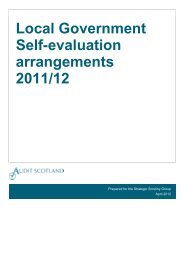Scottish Further Education Funding Council: A ... - Audit Scotland
Scottish Further Education Funding Council: A ... - Audit Scotland
Scottish Further Education Funding Council: A ... - Audit Scotland
You also want an ePaper? Increase the reach of your titles
YUMPU automatically turns print PDFs into web optimized ePapers that Google loves.
Part 3. Initiatives to address the adequacy and efficiency of the provision of further education 133.5 The <strong>Funding</strong> <strong>Council</strong> recognisesthe need to ensure that collegescontinue to apply good practicein management. A new financialmemorandum, which will come intoforce in January 2006, places greateremphasis on the responsibility ofboards of management to drivecontinuous improvement andin accounting for their college’sperformance. SFEFC has providedguidance and funding to supportthe continuing training of boardmembers, and the <strong>Funding</strong> <strong>Council</strong>intends to hold regular meetings withall colleges to discuss their progressagainst strategic objectives.Supply and demand3.6 SFEFC completed its first reviewof the links between supply anddemand across the further educationsector in 2000. The primary purposeof the exercise was to provideinformation to lead a strategicplanning process across colleges toassess the adequacy and efficiencyof further education in <strong>Scotland</strong>. SFEFCcommissioned two separate exercisesto map information on supply anddemand, on a geographical basis andon an industry basis.3.7 In 2002, the <strong>Audit</strong> Committee’sseventh report called on SFEFC tosuccessfully complete its research toestablish levels of supply and demandfor further education in <strong>Scotland</strong>. Thecommittee recommended thatSFEFC publish a step-by-stepprogramme for the implementationof the process to ensure propercoordination and that, once completed,the projects should form the basis ofstrategic planning by colleges.3.8 In 2003, the AGS’s performancemanagement report recorded thatSFEFC’s industry mapping exercisewas abandoned after contractualdifficulties but that the geographicalmapping had been completed.SFEFC had discussed the resultswith colleges and was planning torefine the measurement of supplyand demand to include a widergroup of stakeholders.3.9 In his evidence to the <strong>Audit</strong>Committee in November 2003, thechief executive of SFEFC confirmedthat the <strong>Funding</strong> <strong>Council</strong> wascommissioning a further supplyand demand report. This would helpSFEFC to assess the extent to whichit satisfied its statutory requirement‘to secure the provision of adequateand efficient further education in<strong>Scotland</strong>.’ The exercise would berepeated every two years to build upreliable information to assess supplyand demand.3.10 The next report was commissionedin April 2004 with a remit to givepolicymakers and providers a morecomprehensive picture of demand,need and supply for policydevelopment, and an improved basison which the strategic educationbusiness decisions of providers andfunders are made. It did not set outto provide definitive answers on,although it is a major contributorin assessing, the extent to whichprevious statutory requirements toprovide adequate and efficient furthereducation in <strong>Scotland</strong> are met.3.11 The report was published inApril 2005 and provides informationon provision in all forms of furthereducation and on demand fromemployers and students. One ofits conclusions was that ‘demandfor further education remainsbuoyant and outstrips supply’.The report drew together over40 area-based indicators coveringdemographic change, current andforecast performance of the <strong>Scottish</strong>economy, labour market indicators,employer data from the <strong>Scottish</strong>Employers Skills Survey 2004,schools performance and schoolleaver data, local authority deprivationindices and SFEFC data on furthereducation learner participation,college activity and strategic change.3.12 SFEFC provided advice tothe new <strong>Funding</strong> <strong>Council</strong> on theimplications of the report; theadvice was issued to collegesin a circular in September 2005.SFEFC based its recommendationson the belief ‘that the council’sinterventions should focus on helpingcolleges and other stakeholdersaddress educational deprivation byimproving the achievement levelsof skills and learning in <strong>Scotland</strong>’sdeprived areas, in order to improveindividuals’ potential employabilityand help more people to becomeand stay economically active.’ Therecommendations included specificaction in Lanarkshire, Glasgow,the Highlands & Islands and theSouth, (Exhibit 7, overleaf). InDecember 2005, the <strong>Funding</strong> <strong>Council</strong>discussed the recommendations andit will consider them further in futuremeetings to make decisions to informfunding allocations for 2006/07.3.13 The circular points out thatthe issue of supply and demand iscomplex and that it is hard to findclear-cut and uncontentious answers.It states that ‘there are tensions orperceived tensions between: the roleof the council and of colleges; socialinclusion and support for growingeconomies; short-term and longer-termtrends; the ability of education tosolve societal problems and someof the expectations put upon thesystem’. The colleges visited duringthe audit held the general view thatissues of supply and demand shouldbe dealt with on a local basis andthat the <strong>Funding</strong> <strong>Council</strong> has no rolein managing supply and demand.3.14 The latest ministerial letterof guidance in November 2005expected the <strong>Funding</strong> <strong>Council</strong> towork with colleges and universitiesto secure a coherent and flexiblepattern of provision that best


